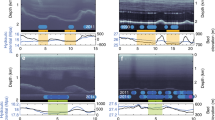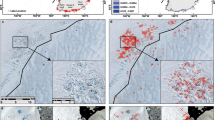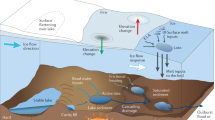Abstract
A set of lakes filled or partially filled with liquid hydrocarbon and empty lake basins have been discovered in the high latitudes of Saturn’s moon Titan1. These features were mapped by the radar instrument on the Cassini orbiter1,2,3,4. Here we quantify the distribution of the lakes and basins, and show a pronounced hemispheric asymmetry in their occurrence. Whereas significant fractions of the northern high latitudes are covered by filled and empty lakes5, the same latitudes in the southern hemisphere are largely devoid of such features. We propose that in addition to known seasonal changes, the observed difference in lake distribution may be caused by an asymmetry in the seasons on Titan that results from the eccentricity of Saturn’s orbit around the Sun. We suggest that the consequent hemispheric difference in the balance between evaporation and precipitation could lead to an accumulation of lakes in one of Titan’s hemispheres. This effect would be modulated by, and reverse with, dynamical variations in the orbit. We propose that much like in the Earth’s glacial cycles, the resulting vigorous hydrologic cycle6 has a period of tens of thousands of years and leads to active geologic surface modification in the polar latitudes.
This is a preview of subscription content, access via your institution
Access options
Subscribe to this journal
Receive 12 print issues and online access
$259.00 per year
only $21.58 per issue
Buy this article
- Purchase on Springer Link
- Instant access to full article PDF
Prices may be subject to local taxes which are calculated during checkout



Similar content being viewed by others
References
Stofan, E. R. et al. The lakes of Titan. Nature 445, 61–64 (2007).
Elachi, C. et al. Cassini radar views the surface of Titan. Science 308, 970–974 (2005).
Turtle, E. P. et al. Cassini imaging of Titan’s high-latitude lakes, clouds, and south-polar surface changes. Geophys. Res. Lett. 36, L02203 (2009).
Elachi, C. et al. Radar: The Cassini Titan RADAR mapper. Space Sci. Rev. 115, 71–110 (2004).
Hayes, A. et al. Hydrocarbon lakes on Titan: Distribution and interaction with a porous regolith. Geophys. Res. Lett. 35, L09204 (2008).
Lunine, J. I. & Lorenz, R. D. Rivers, lakes, dunes, and rain: Crustal processes in Titan’s methane cycle. Annu. Rev. Earth Planet. Sci. 37, 299–320 (2009).
Lorenz, R. D. et al. Titan’s north–south asymmetry from HST and Voyager imaging: Comparison with models and ground-based photometry. Icarus 127, 173–189 (1997).
Lorenz, R. D., Lemmon, M. T., Smith, P. H. & Lockwood, G. W. Seasonal change on Titan observed with the Hubble Space Telescope WFPC-2. Icarus 142, 391–401 (1999).
Mitri, G., Showman, A. P., Lunine, J. I. & Lorenz, R. D. Hydrocarbon lakes on Titan. Icarus 186, 385–394 (2007).
Lunine, J. I. et al. Lack of south polar methane lakes on Titan. Lunar Planet. Inst. Conf. Abstracts 39, 1637 (2008).
Stevenson, D. J. & Potter, B. E. Titans latitudinal temperature distribution and seasonal cycle. Geophys. Res. Lett. 13, 93–96 (1986).
Hayes, A. et al. Evidence for Transient Surface Liquid in Titans South Polar Region. AAS/Division for Planetary Sciences Meeting Abstracts Vol. 41, 21.02 (American Astronomical Society, 2009).
Mitchell, J. L. The drying of Titan’s dunes: Titan’s methane hydrology and its impact on atmospheric circulation. J. Geophys. Res. 113, E08015 (2008).
Zebker, H. A. et al. Size and shape of saturn’s moon Titan. Science 324, 921–923 (2009).
Janssen, M. A. et al. Titans surface at 2.2-cm wavelength imaged by the Cassini radar radiometre: Calibration and first results. Icarus 200, 222–239 (2009).
Giorgini, J. D. et al. JPL’s on-line solar system data service. Bull. Am. Astron. Soc. 28, 1158 (1996).
Barnes, J. W. et al. Shoreline features of Titan’s Ontario Lacus from Cassini/VIMS observations. Icarus 201, 217–225 (2009).
Brown, R. H. et al. The identification of liquid ethane in Titan’s Ontario Lacus. Nature 454, 607–610 (2008).
Newman, C. E., Richardson, M. I., Lee, C., Toigo, A. D. & Ewald, S. P. The Titan WRF Model at the end of the Cassini Prime Mission. Eos 89, AGU Fall Meet. Abstr. (2008).
Graves, S. D. B., Schneider, T. & Schaller, E. L. The climate and seasonal cycle on Titan: Atmospheric dynamics and methane cycle. Division of Planetary Sciences, AAS, abstr. 17.09 (2009).
Setzmann, U. & Wagner, W. A new equation of state and tables of thermodynamic properties for methane covering the range from the melting line to 625 K at pressures up to 1,000 MPa. J. Phys. Chem. Ref. Data 20, 1061–1155 (1991).
McKay, C. P., Pollack, J. B. & Courtin, R. The greenhouse and antigreenhouse effects on Titan. Science 253, 1118–1121 (1991).
Levison, H. F. & Duncan, M. J. The long-term dynamical behaviour of short-period comets. Icarus 108, 18–36 (1994).
Wisdom, J. & Holman, M. Symplectic maps for the n-body problem. Astron. J. 102, 1528–1538 (1991).
Tokano, T., Neubauer, F. M., Laube, M. & McKay, C. P. Seasonal variation of Titans atmospheric structure simulated by a general circulation model. Planet. Space Sci. 47, 493–520 (1999).
Lorenz, R. D., West, R. D. & Johnson, W. T. K. Cassini radar constraint on Titan’s winter polar precipitation. Icarus 195, 812–816 (2008).
Paillou, P. et al. Microwave dielectric constant of Titan-relevant materials. Geophys. Res. Lett. 35, L18202 (2008).
Lorenz, R. D. et al. Titan’s young surface: Initial impact crater survey by Cassini RADAR and model comparison. Geophys. Res. Lett. 34, L07204 (2007).
Wood, C. et al. Impact craters on Titan. Icarus 10.1016/j.icarus.2009.08.021 (in the press).
Acknowledgements
We would like to thank E. Schaller, M. Brown, M. Richardson, C. Newman, T. Schneider and K. Lewis for helpful discussions. This work was partially supported by the Cassini Project. O.A. would like to thank R. Sari, Y. Erel and the Hebrew University of Jerusalem, Israel, for hosting him while carrying out this work.
Author information
Authors and Affiliations
Contributions
O.A., A.G.H., J.I.L. and R.D.L. contributed data analysis and development of the hypothesis; M.D.A. and A.G.H. carried out the computation of the orbital elements; C.E. is the Cassini Radar instrument principal investigator.
Corresponding author
Rights and permissions
About this article
Cite this article
Aharonson, O., Hayes, A., Lunine, J. et al. An asymmetric distribution of lakes on Titan as a possible consequence of orbital forcing. Nature Geosci 2, 851–854 (2009). https://doi.org/10.1038/ngeo698
Received:
Accepted:
Published:
Issue Date:
DOI: https://doi.org/10.1038/ngeo698
This article is cited by
-
Exploration of Enceladus and Titan: investigating ocean worlds’ evolution and habitability in the Saturn system
Experimental Astronomy (2022)
-
Science goals and new mission concepts for future exploration of Titan’s atmosphere, geology and habitability: titan POlar scout/orbitEr and in situ lake lander and DrONe explorer (POSEIDON)
Experimental Astronomy (2022)
-
Possible explosion crater origin of small lake basins with raised rims on Titan
Nature Geoscience (2019)
-
Deep and methane-rich lakes on Titan
Nature Astronomy (2019)
-
Normal modes and resonance in Ontario Lacus: a hydrocarbon lake of Titan
Ocean Dynamics (2019)



